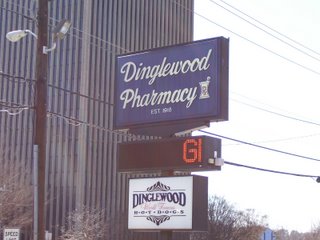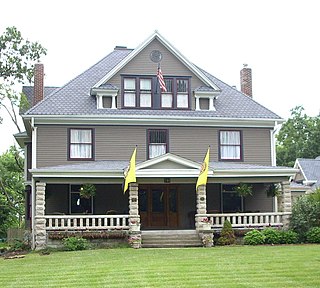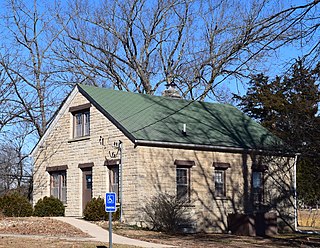The Old Dauphin Way Historic District is a historic district in the city of Mobile, Alabama, United States. It was named for Dauphin Way, now known as Dauphin Street, which bisects the center of the district from east to west. The district is roughly bounded by Broad Street on the east, Springhill Avenue on the north, Government Street on the south, and Houston Avenue on the west. Covering 766 acres (3.10 km2) and containing 1466 contributing buildings, Old Dauphin Way is the largest historic district in Mobile.

The Coca-Cola Bottling Company Building, also known as the Kelly Press Building, is a historic commercial building located on Hitt Street in downtown Columbia, Missouri. It was built in 1935, and is a 1 1/2-story, Colonial Revival style brick building with a side gable roof with three dormers. It has a long one-story rear ell. Today it houses Uprise Bakery, Ragtag Cinema, Ninth Street Video, and Hitt Records.

East Campus is a neighborhood of Columbia, Missouri directly east of the University of Missouri and downtown Columbia. The area contains historic residential property as well many Greek student organizations houses. The district contains parts of Stephens College, the Boone Hospital Center's campus and the historic Lee Street Deli. It developed between about 1895 and 1945, and includes representative examples of Tudor Revival, Colonial Revival, and Bungalow / American Craftsman style architecture.

The Yale Avenue Historic District is a residential historic district near the center of Wakefield, Massachusetts. It encompasses eight residential properties, all but one of which were developed in the 1860s and 1870s, after the arrival of the railroad in town. These properties were built primarily for Boston businessmen, and mark the start of Wakefield's transition to a suburb.

Wakefield Park Historic District is a residential historic district encompassing a portion of a late-19th/early-20th century planned development in western Wakefield, Massachusetts. The district encompasses sixteen properties on 8 acres (3.2 ha) of land out of the approximately 100 acres (40 ha) that comprised the original development. Most of the properties in the district are on Park Avenue, with a few located on immediately adjacent streets.

Dinglewood is a neighborhood/subdistrict located at the southern edge of Midtown Columbus, Georgia. In it is the tallest building in Columbus, the Aflac Tower. It is also home to the famous Dinglewood Pharmacy, which serves, in the opinions of the city's residents, the city's best scrambled hot dog. The boundaries of the neighborhood are generally acknowledged to be 17th Street to the north, Martin Luther King Jr. Boulevard to the south, Interstate 185 to the east and Veterans Parkway to the west. In 2007, the estimated population of the area was 1,101.

Boonville station is a historic train station located at Boonville, Cooper County, Missouri. It was built in 1912 by the Missouri–Kansas–Texas Railroad. It is a one-story, nine bay, Mission Revival-Spanish Colonial Revival style building sheathed in stucco. A projecting bay which houses a telegrapher's station and the patrons' and trainmen's lobby. It features stepped and arched brick parapets at each gable end supported by three arched columns.

There are nine historic districts in Meridian, Mississippi. Each of these districts is listed on the National Register of Historic Places. One district, Meridian Downtown Historic District, is a combination of two older districts, Meridian Urban Center Historic District and Union Station Historic District. Many architectural styles are present in the districts, most from the late 19th century and early 20th century, including Queen Anne, Colonial Revival, Italianate, Art Deco, Late Victorian, and Bungalow.

The John N. and Elizabeth Taylor House is a historic home in Columbia, Missouri which has been restored and once operated as a bed and breakfast. The house was constructed in 1909 and is a 2+1⁄2-story, Colonial Revival style frame dwelling. It features a wide front porch and side porte cochere. The home was featured on HGTV special called "If walls could talk."

Sinking Springs Farms is a historic farm and national historic district located at Manchester Township in York County, Pennsylvania.

The Gasquet Ranger Station Historic District comprises a compound of buildings associated with the Gasquet Ranger District of Six Rivers National Forest. The U.S. Forest Service complex is located along the Smith River on U.S. Route 199 in Del Norte County, California, within Smith River National Recreation Area. Most of the buildings were built by the Civilian Conservation Corps between 1933 and 1939. Seven buildings and a rock wall remain of the CCC-built structures. The district office, the assistant district ranger's residence, a warehouse, two garages and a fuel house were built in the Forest Service rustic style that prevailed at the time. The style is reflected in distinctive detailing, including a recurring pine tree cut-out logo that appears on gables and shutters.
Cassville Ranger Station Historic District is a national historic district near Cassville, Barry County, Missouri. It encompasses five frame and limestone buildings constructed by Civilian Conservation Corps in 1936:

Robert Felix and Elma Taylor Wichterich House, also known as the Wichterich-Lang House, is a historic home located at Cape Girardeau, Missouri. It was built in 1906, and is a 2+1⁄2-story, brick dwelling with Colonial Revival style design elements. It features a fine wraparound verandah with Ionic order capitals and a pedimented gable with a Palladian window.

Courthouse–Seminary Neighborhood Historic District is a national historic district located at Cape Girardeau, Cape Girardeau County, Missouri. The district encompasses 121 contributing buildings and 2 contributing sites in a predominantly residential section of Cape Girardeau. It developed between about 1848 and 1948, and includes representative examples of Italianate, Queen Anne, Colonial Revival, Tudor Revival, Mission Revival, Late Gothic Revival, American Craftsman, and Art Deco style architecture. The district contains 1 1/2 and 2 1/2-story brick single-family homes, with multi-family homes and a few commercial buildings dispersed throughout. Located in the district is the separately listed Robert Felix and Elma Taylor Wichterich House, William Henry and Lilla Luce Harrison House, Huhn-Harrison House, B'Nai Israel Synagogue, St. Vincent de Paul Catholic Church, August and Amalia Shivelbine House, Glenn House, House at 323 Themis Street, and George Boardman Clark House.
Pleasant Hill Downtown Historic District is a national historic district in Pleasant Hill, Cass County, Missouri. The district includes 53 contributing buildings, a contributing site, and a contributing structure in the central business district of Pleasant Hill. It developed between about 1865 and 1959, and includes representative examples of Italianate, Jacobethan Revival, Colonial Revival, Classical Revival, and Modern Movement style architecture. Notable buildings include:

Ava Ranger Station Historic District is a national historic district located near Ava, Douglas County, Missouri. The district encompasses five frame and limestone buildings constructed by Civilian Conservation Corps in 1936. They are the 1 1/2-story, Colonial Revival style Ranger's Office; 1 1/2-story, Colonial Revival style Ranger's Dwelling; garage; warehouse and an oil house. It continues to be used as a Ranger Station for the Mark Twain National Forest.

Rolla Ranger Station Historic District is a historic ranger station and national historic district located at Mark Twain National Forest near Rolla, Phelps County, Missouri. The station includes five frame and limestone buildings constructed by the Civilian Conservation Corps (CCC) during 1937 and 1938. They were built under the supervision of a Works Progress Administration (WPA) project. They are a ranger's office, dwelling, garage, warehouse and oil house. The ranger's office and dwelling are 1 1/2-story, Colonial Revival influenced buildings.
Winona Ranger Station Historic District is a historic ranger station and national historic district located in Mark Twain National Forest near Winona, Shannon County, Missouri. The district encompasses four contributing buildings, associated with a ranger station constructed by the Civilian Conservation Corps (CCC) under the supervision of a Works Progress Administration (WPA) project. It developed between 1938 and 1938 and includes 1+1⁄2-story, Colonial Revival style ranger's dwelling, garage, warehouse, and oil house.
George William Hellmuth (1870-1955) was an American architect based in St. Louis, Missouri.

The Marine Villa Neighborhood Historic District is a residential historic district in the Marine Villa neighborhood of St. Louis, Missouri, United States. The district encompasses ten blocks and includes 356 buildings and sites, 187 of which are considered contributing resources to the district's historic character. Construction in the area began in 1870, but poor infrastructure and street access limited settlement. A streetcar line opened on South Broadway in 1890, leading the district to develop into one of St. Louis' many streetcar suburbs of the era. Most of the neighborhood's early residents were working-class and middle-class German immigrants and their families. The district's buildings are mainly one- and two-story brick buildings, and as the majority were built by individual property owners, they feature a wide variety of styles and shapes; the architectural styles used in the district include Spanish Colonial Revival, Romanesque Revival, Colonial Revival, Tudor Revival, Italianate, and Second Empire.


















